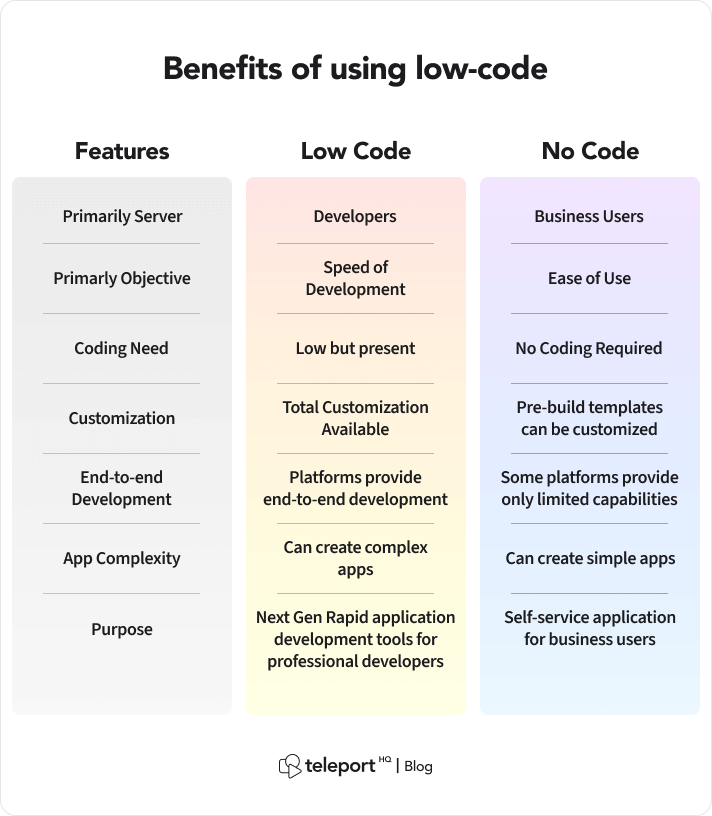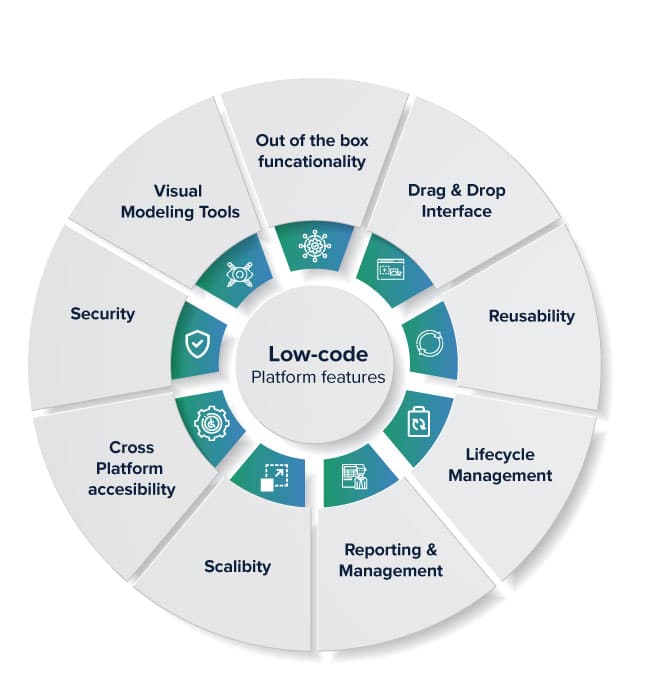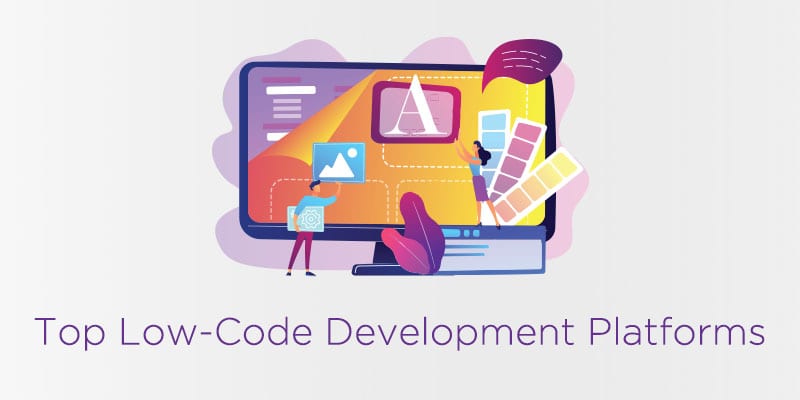Top Facts On Deciding On Low-code platforms for application development
Wiki Article
Benefits Of Low-Code Development For Non-Developers In Terms Accessibility
Because of a variety of factors, Low-code Application Development is available to non-developers. These are known as "citizen designers."
Drag-and Drop Builders: Low-code platforms come with drag-and-drop interfaces that allow non-developers to develop applications without needing to write code. The development process is now more accessible for those who have no technical background.
WYSIWYG Editors: "What You See Is What You Receive" editors enable users to design interfaces and workflows in an approach that is similar to the final product, making it simpler to comprehend and use.
Simplified Workflow and Logic Design:
Visual Workflow Design: Users can easily design business process and application logic by using flowcharts, models and diagrams. They are much easier to work with than traditional coding.
Pre-built Logic Components: Low-code platforms typically contain pre-built logic components (e.g. statements that are conditional, loops) which can be easily modified, eliminating the need for complicated programming.
Reusable Components & Templates
Library of Templates pre-built: Numerous platforms that provide low-code come with a library of template types for the most common applications. This lets developers begin their journey quickly and effortlessly while non-developers are able to customize the templates as they see appropriate.
Reusable widgets and modules: The creation of web pages is made simpler by using reusable components and modules. This eliminates the need for deep technical knowledge.
Guided Development and Tutorials
Step-by-Step guides: Platforms provide instructions and help on screen to non-developers who are building applications.
Interactive Tutorials - Interactive tutorials that allow you to engage with the platform can help you learn and gain confidence.
Integration with Existing Tool:
Seamless Integration - Low-code platforms can easily be integrated with existing business tools and systems (e.g. ERP CRM, ERP) that give even non-developers to develop apps that work within their workflows.
APIs and Connectors: APIs built-in and connectors let non-developers and users to easily connect applications to external services without the need to write complex programming.
Collaboration Features:
Team Collaboration: Features like real-time collaboration workspaces and shared workspaces allow for non-developers to effectively collaborate with developers, business analyst, and other stakeholders.
Role-based Access Control: Developers are assigned roles that have appropriate access levels, ensuring they are able to contribute to the process of development without having to compromise security or function.
Automated testing and debugging
Low-code platforms include tools for testing and debugging which are built into. They automate this process so it is easier for nondevelopers to ensure their apps run.
Error Highlighting: When issues arise, the platform highlights mistakes and suggests solutions by guiding non-developers through troubleshooting techniques.
The main benefit of developing applications using low-code in terms of accessibility to non-developers lies in its ability to make the development process more accessible. Platforms that use low-code empower business users by offering them an intuitive, visually and logical tools. They are then able to actively participate in developing and maintaining applications. Take a look at the top rated Low-code Platform for application development advice for site examples including rapid action development, azure sql server, rapid applications, build with docker, azure sql databases, application development platforms, paas service, cross platform mobile dev, azure sql, ms azure sql and more.

Benefits Low-Code Apps In Governance And Safety
Low-code application design offers many advantages in terms of security and governance. Both are crucial for making sure that apps remain safe, compliant and properly managed throughout their entire life cycle. Below are the advantages of developing low-code applications:
Unified Management Console: Low-code platforms typically offer a central management console that allows administrators to oversee and manage all applications to ensure a uniform governance throughout the entire organization.
Role-Based Access Control RBAC (RBAC). These platforms often have robust access control that is by role, which gives administrators to create and enforce their own access policies. This makes sure that only authorized users can access or modify certain areas of the application.
Compliance and Regulatory Conformity:
Built-in Compliance Features: A lot of low-code platforms are built to conform to the industry standards as well as regulations (e.g., GDPR, HIPAA). They offer templates and tools to ensure that the applications are compliant with these requirements.
Audit Trails and Logging: Audit trails and logs that are comprehensive are usually combined, allowing businesses to monitor changes, track access and ensure compliance with internal and external regulations.
Additional Security Measures
Data encryption. Low-code platforms usually have built-in encryption for data when in transit as well as when at rest. This helps protect sensitive information.
Security Certificates: A lot of low-code companies have a security certificate (e.g. ISO 27001 and SOC 2) which demonstrate they adhere to the strictest security standards. They also provide an extra security level to their customers.
Automated security updates:
Regular Patching and Updates Low-code platforms usually handle patches and security updates automatically, ensuring that applications are safe from latest threats without developer intervention manually.
Security Monitoring - Continuous security monitoring is often included. This provides real-time insights and alerts on potential security threats.
Data Governance
Data Access Policy: These systems allow companies define and enforce rules regarding data access, ensuring sure that only authorized individuals are able to access data, and they are using it in a proper manner.
Data Masking and Anonymization Built in tools for data masking & anonymization ensure the security of sensitive information, especially in development environments and testing environments.
Consistent Management of the lifecycle of an application
Development and deployment pipelines Lowcode platforms usually provide integrated development-and-deployment pipelines with security tests. They ensure security throughout the application's lifecycle.
Version Control - Integrated version controls help monitor modifications to applications and allow the application to be reversed in the event of need. They also ensure the integrity and quality of the application.
User Authentication, Authorization, and Authorization
Single Sign-On (SSO): Support for single sign-on as well as other advanced authentication techniques makes managing users easier and increases security.
Multi-Factor Authentication : Many platforms include integrated multi-factor authentication, which adds an extra layer of security to accessing applications.
Policy Enforcement Monitoring and Compliance:
Low-code platforms often come with policies templates pre-defined that enable organizations to implement governance and cybersecurity policies quickly.
Tools for Monitoring Compliance They provide constant monitoring and reports about compliance levels, which makes it easier to spot and fix any issues that could arise.
Integrating with Existing Security Infrastructure
Seamless Integration: Platforms with low-code technology are built to integrate seamlessly with tools and infrastructure, such as SIEM (Security Information and Event Management solutions) and firewalls.
API Security: Built-in API security features make sure that integrations with external systems are safe, safeguarding information and ensuring the integrity of the application.
Training and Best Practices:
Guided Best Practices: Many platforms offer guidelines and best practices for secure application development, helping non-developers adhere to security standards.
Certain low-code companies offer security education to help users build and maintain secure applications.
Overall, the governance and security benefits of low-code development assure that the applications are developed and maintained in a safe, compliant, and controlled way. These platforms offer the tools and frameworks needed to protect sensitive information and enforce policies, as well as maintain regulatory compliance, while facilitating the management and oversight. Follow the recommended Legacy application modernization with Low-code for blog examples including azure sql, app development platform, software for app development, cross platform app development, build a docker container, develop mobile application, push alerts, rad application development, cloud software applications, rapid applications and more.

Advantages Of Low-Code Application Development In Terms Of Limitations And The Possibility Of Customizing
Low-code design for applications is an equilibrative, flexible method that overcomes issues and permits modification. These are the key advantages: Handling Limitations
Overcoming Complexity Barriers
Simplified development: Low code platforms simplify the process by offering templates and pre-built components. This helps speed up application deployment, even for complex ones.
Guided Workflows Many platforms offer wizards and workflows that guide developers through complex processes. This reduces the possibility of error and ensures consistency.
Scalability Solutions
Built-in Scalability: Low-code platforms often include features that support scalable architecture, allowing applications to take on more load without requiring significant changes.
Performance Monitoring: The integrated tools for monitoring performance and optimization can ensure that applications remain efficient when they grow.
Security and Compliance
Integrated Security Features : Low codes platforms have security features that are built in like encryption and role-based access controls. They also run automated checks of compliance to address security concerns.
Regular Updates: Platforms frequently update their security protocols and compliance measures, ensuring that applications are protected against emerging threats.
Customization Options:
Extensibility:
Low-code platforms can often be able to integrate custom-written code such as JavaScript or Python, allowing developers to enhance their capabilities beyond what is standard.
Customized plugins and modules Developers can design custom plugins or modules to add specific functionalities tailored to specific business needs.
APIs and Integration
API Support: Full API support permits seamless integration of other systems and services. This allows for large customization and connection.
Third-Party Services : Low-code platforms often provides pre-built connections for well-known services offered by third parties which makes integration and customization simpler.
Flexible Design for UI/UX:
User interfaces that can be customized: Developers are able to modify and design user interfaces in order to satisfy specific branding requirements and requirements for usability, resulting in an experience that is customized for users.
Responsive design: The ability to tailor applications for various screens and devices is included.
Business Logic Customization
Visual Workflow Builders Visual tools for creating and customizing workflows and business logic enable developers to develop complex, customized processes without extensive programming.
Conditional Logic and scripting: Platforms allow the integration of conditional logic and custom scripting that can handle certain business rules and scenarios.
Data Management:
Custom Data Modelling: Developers define custom models to fit specific application needs. They can adapt data handling to the business's requirements.
Advanced Data processing Integration advanced tools for data handling allow for customisation of data analysis and use within the application.
Balance Customization and Limitations:
Frameworks & Standards
Best Practices in Compliance Low-code platforms facilitate adhering to industry best practices and standards. This assists in maintaining high-quality robust, and secure applications.
Governance Frameworks Governance Frameworks: Integrated governance frameworks ensure that the customizations do not affect the integrity, compliance, or the security of an application.
Iterative Development:
Rapid Prototyping. The ability to speedily prototyping and testing modifications lets developers tweak the app based on the feedback of users. This helps to refine the app to better meet the requirements of users.
Low-code platforms are built to allow for continuous enhancement. This allows for customizations and improvements as requirements for business change.
Users Empowerment
The empowerment of citizens-developers through low-code platforms can increase the number developers who are capable of improving and modifying applications through allowing them to customize through an intuitive user interface.
Training and Support Many platforms provide extensive training and resources to support users as they customize their applications, without compromising its stability or performance.
Low-code applications provide a flexible framework that can be customized to meet the specific requirements. This allows businesses to build and maintain apps that are both functional as well as tailored to meet specific business requirements. While maintaining high quality, security scaleability, standards, and security.
